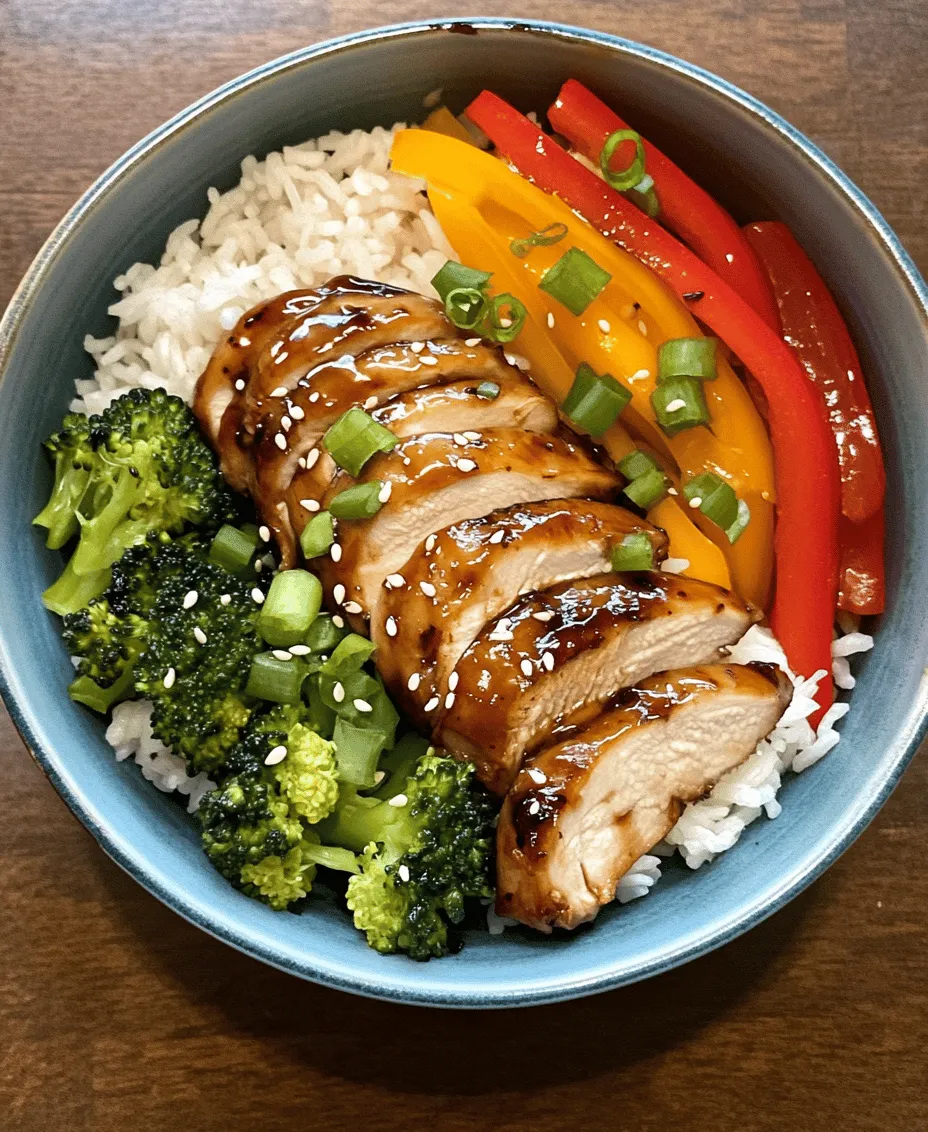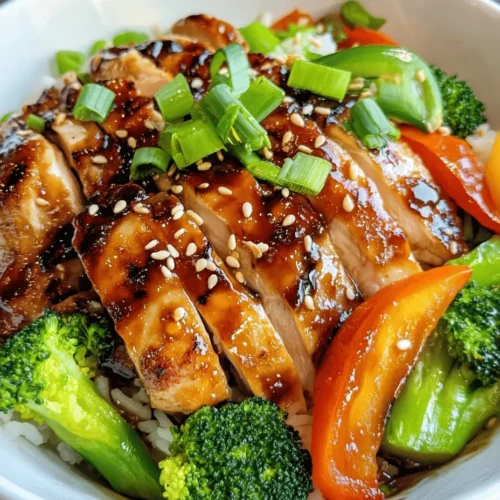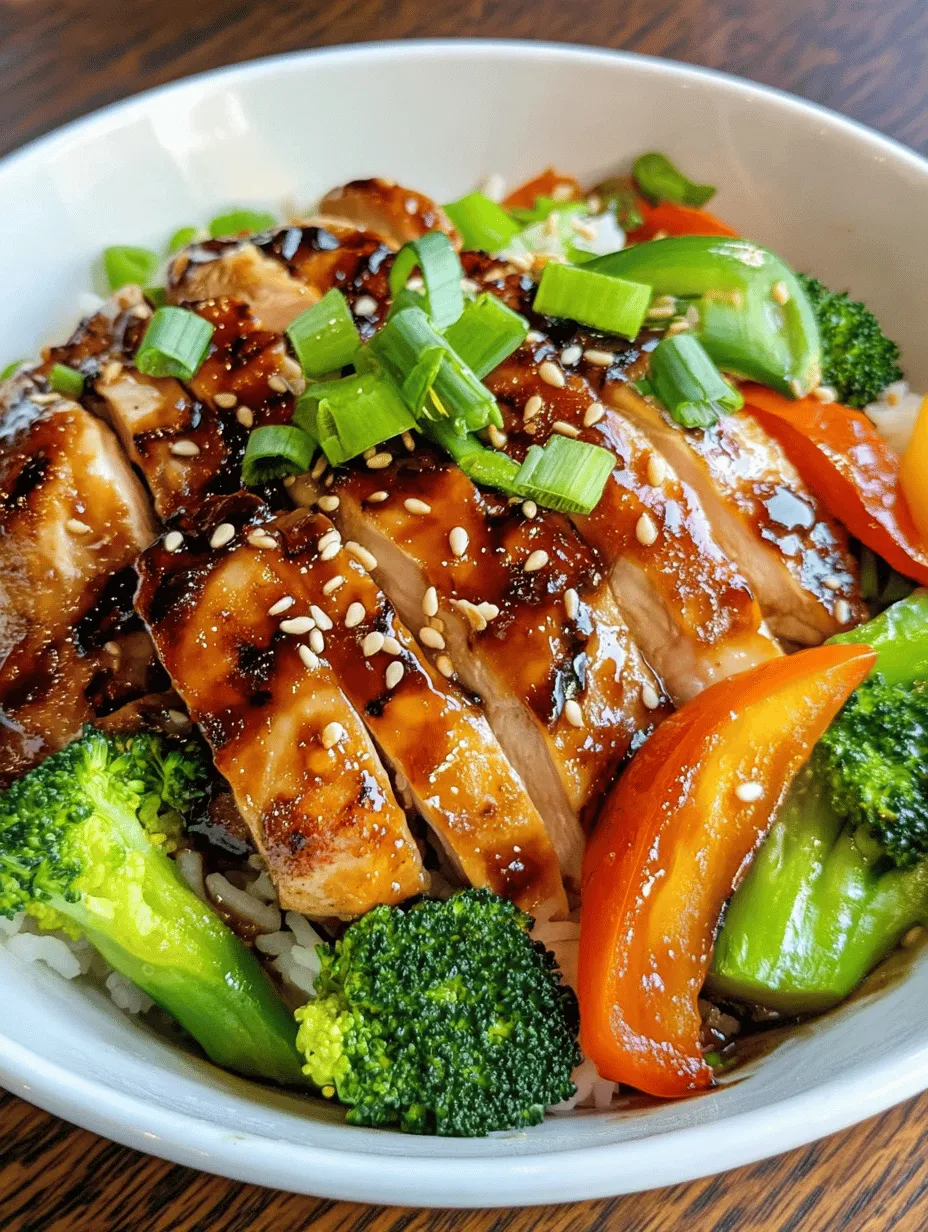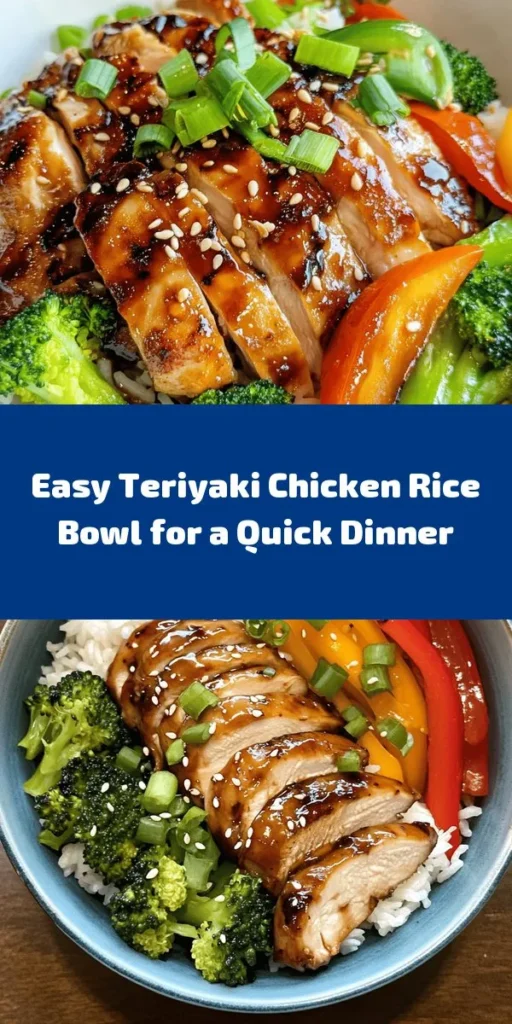Introduction
The Teriyaki Chicken Rice Bowl is a beloved dish that brings together the delightful flavors of Japanese cuisine with the nutritional benefits of a wholesome meal. Known for its harmonious blend of sweet, savory, and umami flavors, this dish has garnered a significant following among food enthusiasts around the world. The appeal of the Teriyaki Chicken Rice Bowl lies not only in its taste but also in its simplicity and versatility. It’s a meal that can be easily prepared on a weeknight, making it perfect for busy families or anyone looking for a delicious yet quick dinner option.
One of the standout features of this dish is its customizability. While the classic version typically includes tender chicken, rice, and a few vegetables, the recipe can be adapted to suit individual preferences. Whether you’re looking to add more veggies, switch out the protein for tofu or beef, or even experiment with different sauces, the Teriyaki Chicken Rice Bowl allows for endless creativity. This makes it an excellent choice for meal prep, ensuring that every bowl can be tailored to meet unique tastes and dietary needs.
Understanding Teriyaki: A Brief History
The term “teriyaki” is derived from two Japanese words: “teri,” which refers to a glaze or sheen, and “yaki,” meaning to grill or broil. Teriyaki sauce, a blend of soy sauce, mirin (a sweet rice wine), and sugar, has its roots in traditional Japanese cooking. Its origins can be traced back to the Edo period (1603-1868) when it was used to enhance the flavor of grilled meats and fish. Over the years, teriyaki has evolved beyond its traditional confines, becoming a staple in both Japanese and Western cuisines.
In modern culinary practices, teriyaki is celebrated for its versatility. While traditional teriyaki dishes often emphasize simplicity and the natural flavors of the main ingredients, contemporary interpretations have embraced a wider range of flavors and cooking techniques. Today, teriyaki sauce is frequently used not only as a marinade but also as a finishing glaze for grilled meats, stir-fries, and even as a dipping sauce. This evolution highlights how teriyaki has transcended its origins, becoming a global favorite that resonates with diverse palates.
Ingredients Overview
Creating a delicious Teriyaki Chicken Rice Bowl begins with a selection of high-quality ingredients. Each component plays a vital role in ensuring that the final dish is bursting with flavor and nutrition. Here’s a closer look at the key ingredients:
– Boneless, Skinless Chicken Thighs: While you may come across recipes that use chicken breasts, boneless, skinless chicken thighs are often favored for this dish. Thighs are juicier and more flavorful, making them less likely to dry out during cooking. Their higher fat content also allows them to absorb the flavors of the teriyaki sauce more effectively, resulting in a tender and succulent chicken.
– Jasmine Rice: This fragrant rice variety is known for its slightly floral aroma and soft, sticky texture when cooked. Jasmine rice pairs beautifully with teriyaki chicken, as it absorbs the sauce well, creating a harmonious blend of flavors. The fluffy texture of jasmine rice complements the tender chicken and crisp vegetables, making it an ideal base for the dish.
– Soy Sauce: Soy sauce is the cornerstone of teriyaki sauce, providing that essential umami flavor. When selecting soy sauce, it’s important to consider the quality. Regular soy sauce offers a robust flavor, while low-sodium varieties can be used for those watching their salt intake. Using a high-quality soy sauce can make a significant difference in the overall taste of the dish.
– Honey: Honey adds a natural sweetness that balances the salty and savory elements of the dish. It also contributes to the glossy finish of the teriyaki sauce when cooked. For a vegan alternative, maple syrup or agave nectar can be used instead.
– Rice Vinegar and Sesame Oil: These ingredients enhance the complexity of the dish. Rice vinegar adds a touch of acidity that brightens the flavors, while sesame oil introduces a nutty aroma that complements the chicken perfectly. A few drops of sesame oil can elevate the dish, giving it an authentic Asian flavor profile.
– Garlic and Ginger: These two aromatics are essential for adding depth to the teriyaki sauce. Garlic provides a pungent, savory flavor, while ginger contributes a warm, zesty note. Both ingredients are lauded for their health benefits, including anti-inflammatory properties and digestive support.
– Cornstarch: This ingredient is crucial for thickening the teriyaki sauce, giving it a desirable consistency that clings to the chicken and rice. When combined with water, cornstarch creates a smooth slurry that thickens the sauce as it cooks.
– Vegetables: While the classic teriyaki chicken bowl typically includes bell peppers and broccoli, feel free to incorporate your favorite vegetables. Bell peppers add a sweet crunch, while broccoli provides a vibrant color and important nutrients. Other options might include snap peas, carrots, or bok choy, each contributing their unique flavor and texture to the dish.
Preparation Steps Explained
Now that we’ve explored the essential ingredients, let’s dive into the preparation of the Teriyaki Chicken Rice Bowl. The process can be broken down into a few key steps, ensuring that you achieve maximum flavor and tenderness in your chicken while preparing perfectly cooked rice.
Marinating the Chicken
The first step in creating a mouthwatering Teriyaki Chicken Rice Bowl is to marinate the chicken. Marinating is essential for infusing the meat with flavor and enhancing its tenderness. A good marinade allows the chicken to absorb the sweet and savory notes of the teriyaki sauce, resulting in a more flavorful dish.
For marinating, start by combining soy sauce, honey, minced garlic, and grated ginger in a bowl. You can also add rice vinegar and sesame oil for an extra layer of flavor. Whisk these ingredients together until well combined.
Next, place the boneless, skinless chicken thighs in a resealable plastic bag or a shallow dish. Pour the marinade over the chicken, ensuring that each piece is thoroughly coated. Seal the bag or cover the dish and refrigerate for at least 30 minutes. For optimal flavor absorption, consider marinating the chicken for 1-2 hours, or even overnight if you have the time. This longer marination will result in a richer taste and more tender chicken.
Cooking the Rice
While the chicken marinates, it’s time to prepare the jasmine rice. Cooking rice may seem straightforward, but there are a few techniques that can help you achieve that fluffy, perfect texture.
Start by rinsing the jasmine rice under cold water. This step is crucial as it helps remove excess starch, which can cause the rice to become gummy during cooking. Rinse the rice until the water runs clear, then drain it well.
Next, transfer the rinsed rice to a medium saucepan and add water. The general ratio for jasmine rice is 1 cup of rice to 1.5 cups of water. You can adjust this ratio slightly depending on your preference for softer or firmer rice. Add a pinch of salt to enhance the flavor.
Bring the water to a boil over medium-high heat. Once boiling, reduce the heat to low, cover the saucepan with a lid, and let it simmer for about 15 minutes. Avoid lifting the lid during cooking, as this can release steam and affect the cooking process. After 15 minutes, remove the saucepan from heat and let it sit, covered, for an additional 5-10 minutes. This resting period allows the rice to finish cooking and results in a fluffier texture.
Once the rice is ready, fluff it with a fork before serving. This step helps separate the grains and prevents clumping, ensuring that each bite of rice complements the juicy teriyaki chicken.
Next Steps
With the chicken marinating and the rice cooking, you are well on your way to creating a delicious Teriyaki Chicken Rice Bowl. In the next section, we will dive into the final cooking steps that will bring this dish together, including sautéing the chicken, preparing the sauce, and assembling the bowl for a visually appealing and satisfying meal. Stay tuned for the continuation of this flavorful journey!

Cooking the Chicken: Methods for Ensuring Juicy and Flavorful Chicken
To achieve tender and flavorful chicken in your Teriyaki Chicken Rice Bowl, the cooking method is crucial. One of the best approaches is to grill or pan-sear the chicken. Grilling adds a delightful char and depth of flavor, while pan-searing allows for a perfect caramelization that enhances the dish’s overall taste.
Before cooking, ensure the chicken has marinated adequately. A minimum of 30 minutes is recommended, but for the best results, marinate for 2 to 4 hours, or even overnight if possible. This marination time not only infuses the chicken with flavor but also helps to tenderize the meat, resulting in a juicier texture.
When you’re ready to cook, heat your grill or skillet over medium-high heat and add a small amount of oil to prevent sticking. Place the marinated chicken in the hot pan or on the grill. Cook for about 6-7 minutes on each side, depending on the thickness of the chicken breasts, until the internal temperature reaches 165°F (75°C). This ensures that your chicken is both safe to eat and perfectly cooked.
Marination Impact on Cooking Time and Texture
The marination process is not just about flavor; it also significantly impacts cooking time and texture. When chicken is marinated, the acid from ingredients like soy sauce or vinegar breaks down proteins in the meat, making it more tender. However, if you marinate the chicken for too long, especially in acidic marinades, you risk the chicken becoming mushy. Therefore, it’s essential to find that sweet spot – usually between 30 minutes to 4 hours.
As you cook the marinated chicken, the sugars in the marinade caramelize, creating a beautiful glaze. This caramelization enhances the flavor and gives your chicken a visually appealing color.
Preparing the Sauce: Safety Measures When Using the Marinade
Using the marinade as a sauce can elevate your Teriyaki Chicken Rice Bowl, but it’s important to follow safety measures to avoid cross-contamination. Always separate the marinade used for raw chicken from the portion that will be used as a sauce.
If you want to use the marinade as a sauce, bring it to a boil in a saucepan for at least 5 minutes to kill any harmful bacteria. This step is crucial for food safety. Once boiled, you can reduce the heat and simmer until it thickens slightly, which will enhance the flavor and ensure it’s safe for consumption.
How to Achieve the Perfect Sauce Consistency with Cornstarch
To achieve that perfect Teriyaki sauce consistency, cornstarch is your best friend. After boiling the marinade, mix 1 tablespoon of cornstarch with 2 tablespoons of cold water to create a slurry. This will help thicken the sauce as it cooks.
Once the marinade is boiling, slowly add the cornstarch slurry, whisking continuously. This prevents lumps from forming and ensures a smooth, glossy sauce. Continue to cook for a few minutes until the sauce reaches your desired thickness. The result will be a rich, sticky Teriyaki sauce that clings beautifully to your chicken and vegetables.
Sautéing the Vegetables: Importance of Maintaining Texture and Color
Sautéing the vegetables is an essential step in creating a well-rounded Teriyaki Chicken Rice Bowl. The goal is to maintain the vibrant colors and crisp textures of the vegetables while ensuring they are cooked through.
Begin by preheating your skillet over medium heat and adding a small amount of oil. Popular choices for vegetables in a Teriyaki bowl include bell peppers, broccoli, and carrots. Cut your vegetables into uniform pieces to ensure even cooking.
Add the vegetables to the hot skillet in stages, starting with those that take longer to cook, like carrots and broccoli. Sauté for a few minutes before adding quicker-cooking vegetables like bell peppers. Cook until the vegetables are just tender but still crisp, typically around 5-7 minutes. This method preserves their nutrients and provides a delightful crunch that contrasts nicely with the tender chicken.
Best Practices for Stir-Frying for Maximum Flavor
Stir-frying is an art that can elevate your Teriyaki Chicken Rice Bowl to new heights. To maximize flavor, ensure that your ingredients are prepped and ready before you start cooking. This includes having your chicken cut into bite-sized pieces, vegetables washed and chopped, and your sauce prepared.
Use high heat and a wok or a large skillet to create that signature stir-fry sear. Add your chicken first, allowing it to brown before adding the vegetables. Stir-fry in small batches if necessary, as overcrowding the pan can lead to steaming instead of searing.
Keep the ingredients moving in the pan to prevent sticking and ensure even cooking. The goal is to achieve a slight char on the chicken and vegetables, which enhances flavor through caramelization.
Assembling the Teriyaki Chicken Rice Bowl
Step-by-Step Guide to Plating the Dish for Presentation
Once your chicken, vegetables, and sauce are ready, it’s time to assemble your Teriyaki Chicken Rice Bowl. Start by placing a generous serving of cooked rice in the center of a large bowl. Jasmine or short-grain rice works beautifully for this dish, as it complements the flavors well.
Next, add the sautéed vegetables around the rice, creating a colorful presentation. Slice the cooked chicken into strips and arrange it on top of the rice. Drizzle the thickened Teriyaki sauce over the chicken, ensuring even coverage.
Importance of Balance in Portioning Chicken, Rice, and Vegetables
When assembling your Teriyaki Chicken Rice Bowl, balance is key. Aim for equal portions of protein, carbs, and vegetables to create a satisfying meal. A good rule of thumb is to have about one-third of the bowl filled with chicken, one-third with rice, and one-third with vegetables. This not only ensures a well-rounded meal but also enhances the visual appeal.
Suggestions for Garnishing: Green Onions and Sesame Seeds for Visual Appeal
To finish your Teriyaki Chicken Rice Bowl, garnishing is essential. Sprinkle sliced green onions over the top for a pop of color and a fresh flavor. Additionally, toasted sesame seeds add a delightful crunch and nutty aroma. These garnishes not only elevate the dish’s presentation but also enhance its overall flavor profile.
Nutritional Breakdown of Teriyaki Chicken Rice Bowl
Overview of Calories, Protein, and Other Nutritional Information per Serving
A typical serving of Teriyaki Chicken Rice Bowl contains approximately 500-600 calories, depending on the specific ingredients and portion sizes used. The protein content is substantial, usually around 30-35 grams, thanks to the chicken. The rice provides a good source of carbohydrates, while the vegetables contribute essential vitamins and minerals.
Discussion of Health Benefits of Key Ingredients, Such as Lean Protein and Vegetables
This dish is packed with health benefits. Lean chicken breast is an excellent source of protein, which is vital for muscle repair and growth. The inclusion of a variety of vegetables not only adds fiber but also enhances the meal’s nutritional profile with vitamins A, C, and K.
Brown rice can be an excellent alternative to white rice for added fiber and nutrients. Furthermore, the Teriyaki sauce, made with soy sauce and other natural ingredients, offers a savory flavor without excessive fats, making it a healthier choice for a quick meal.
Considerations for Dietary Restrictions and Substitutions (e.g., Gluten-Free Soy Sauce)
For those with dietary restrictions, this recipe can easily be adapted. To make the Teriyaki Chicken Rice Bowl gluten-free, substitute regular soy sauce with tamari or a gluten-free soy sauce alternative. If you prefer a lighter option, consider using grilled tofu instead of chicken or incorporating shrimp for a seafood twist.
Variations and Customizations
Suggestions for Alternative Proteins (Tofu, Shrimp, Beef)
The beauty of the Teriyaki Chicken Rice Bowl lies in its versatility. For those seeking vegetarian options, tofu is an excellent substitute. Firm tofu can be marinated and cooked in the same way as chicken, absorbing the delicious flavors of the teriyaki sauce.
Shrimp is another fantastic alternative, offering a sweet flavor that pairs well with the sauce. For beef lovers, thinly sliced flank steak can be marinated and cooked quickly, providing a rich taste.
Options for Different Vegetables Based on Seasonality or Preference
Feel free to customize the vegetable selection based on what’s in season or what you prefer. Seasonal vegetables like asparagus, snap peas, or bok choy can add unique flavors and textures. The goal is to incorporate a variety of colors and textures for a visually appealing dish.
Ideas for Making the Dish Spicy or Adding Additional Flavors
If you enjoy heat, consider adding sliced jalapeños or a drizzle of sriracha to your bowl. For additional flavor depth, a sprinkle of five-spice powder or a dash of sesame oil can elevate the dish. Experimenting with different flavor profiles can make this dish your own.
Serving Suggestions and Pairings
Ideas for Side Dishes that Complement the Teriyaki Chicken Rice Bowl (e.g., Miso Soup, Edamame)
To round out your meal, consider serving the Teriyaki Chicken Rice Bowl with complementary side dishes. Miso soup provides a warm and savory contrast, while edamame adds a fun and nutritious finger food option. A simple cucumber salad can also be refreshing and balances the richness of the teriyaki sauce.
Beverage Pairings that Enhance the Dining Experience (e.g., Sake, Green Tea)
For beverage pairings, sake is a classic choice that beautifully complements the flavors of the dish. If you prefer non-alcoholic options, a cup of green tea or iced jasmine tea can enhance the dining experience, adding a refreshing touch to the meal.
Conclusion
The Teriyaki Chicken Rice Bowl is a simple yet delicious dish that highlights the balance of flavors and textures. With its juicy chicken, colorful vegetables, and savory sauce, it’s a meal that is satisfying and healthy. The adaptability of this recipe allows you to tailor it to your taste preferences and dietary needs, making it perfect for various occasions.
I encourage you to try making this Teriyaki Chicken Rice Bowl at home. It’s a straightforward recipe that promises to impress your family and friends while providing a nutritious meal. Whether you’re enjoying it for lunch or dinner, this dish is sure to become a staple in your kitchen, adaptable to whatever ingredients you have on hand. Enjoy the process and the delightful flavors that await you!



